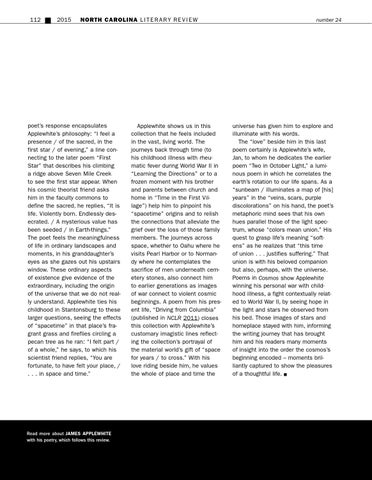112
2015
NORTH CAROLINA L I T E R A R Y RE V I E W
poet’s response encapsulates Applewhite’s philosophy: “I feel a presence / of the sacred, in the first star / of evening,” a line connecting to the later poem “First Star” that describes his climbing a ridge above Seven Mile Creek to see the first star appear. When his cosmic theorist friend asks him in the faculty commons to define the sacred, he replies, “It is life. Violently born. Endlessly desecrated. / A mysterious value has been seeded / in Earth-things.” The poet feels the meaningfulness of life in ordinary landscapes and moments, in his granddaughter’s eyes as she gazes out his upstairs window. These ordinary aspects of existence give evidence of the extraordinary, including the origin of the universe that we do not really understand. Applewhite ties his childhood in Stantonsburg to these larger questions, seeing the effects of “spacetime” in that place’s fragrant grass and fireflies circling a pecan tree as he ran: “I felt part / of a whole,” he says, to which his scientist friend replies, “You are fortunate, to have felt your place, / . . . in space and time.”
Read more about JAMES APPLEWHITE with his poetry, which follows this review.
Applewhite shows us in this collection that he feels included in the vast, living world. The journeys back through time (to his childhood illness with rheumatic fever during World War II in “Learning the Directions” or to a frozen moment with his brother and parents between church and home in “Time in the First Village”) help him to pinpoint his “spacetime” origins and to relish the connections that alleviate the grief over the loss of those family members. The journeys across space, whether to Oahu where he visits Pearl Harbor or to Normandy where he contemplates the sacrifice of men underneath cemetery stones, also connect him to earlier generations as images of war connect to violent cosmic beginnings. A poem from his present life, “Driving from Columbia” (published in NCLR 2011) closes this collection with Applewhite’s customary imagistic lines reflecting the collection’s portrayal of the material world’s gift of “space for years / to cross.” With his love riding beside him, he values the whole of place and time the
number 24
universe has given him to explore and illuminate with his words. The “love” beside him in this last poem certainly is Applewhite’s wife, Jan, to whom he dedicates the earlier poem “Two in October Light,” a luminous poem in which he correlates the earth’s rotation to our life spans. As a “sunbeam / illuminates a map of [his] years” in the “veins, scars, purple discolorations” on his hand, the poet’s metaphoric mind sees that his own hues parallel those of the light spectrum, whose “colors mean union.” His quest to grasp life’s meaning “softens” as he realizes that “this time of union . . . justifies suffering.” That union is with his beloved companion but also, perhaps, with the universe. Poems in Cosmos show Applewhite winning his personal war with childhood illness, a fight contextually related to World War II, by seeing hope in the light and stars he observed from his bed. Those images of stars and homeplace stayed with him, informing the writing journey that has brought him and his readers many moments of insight into the order the cosmos’s beginning encoded – moments brilliantly captured to show the pleasures of a thoughtful life. n
